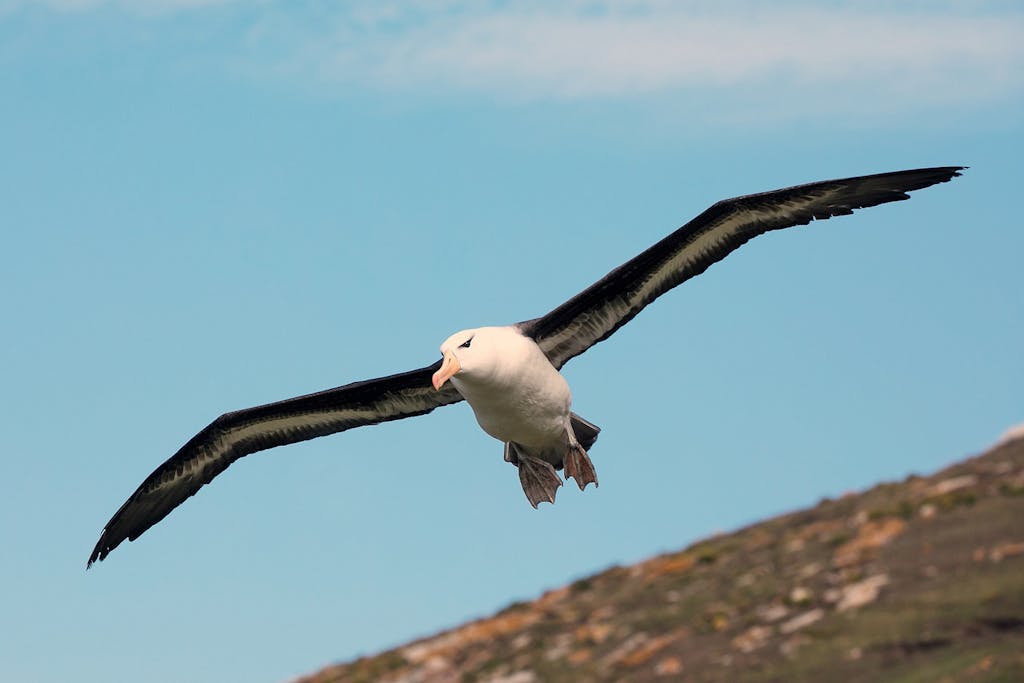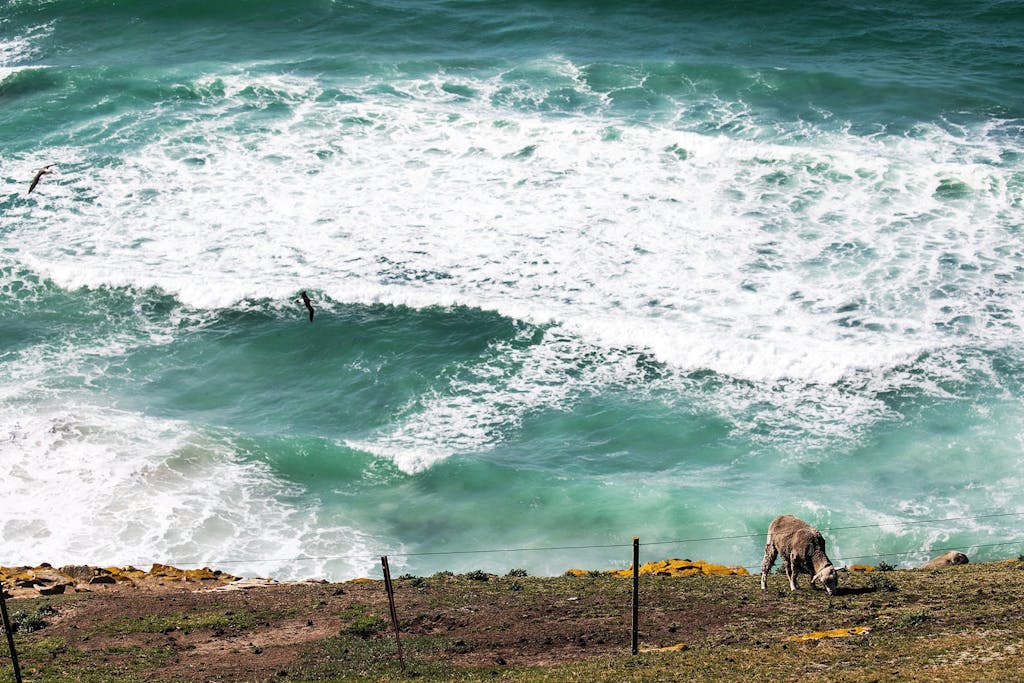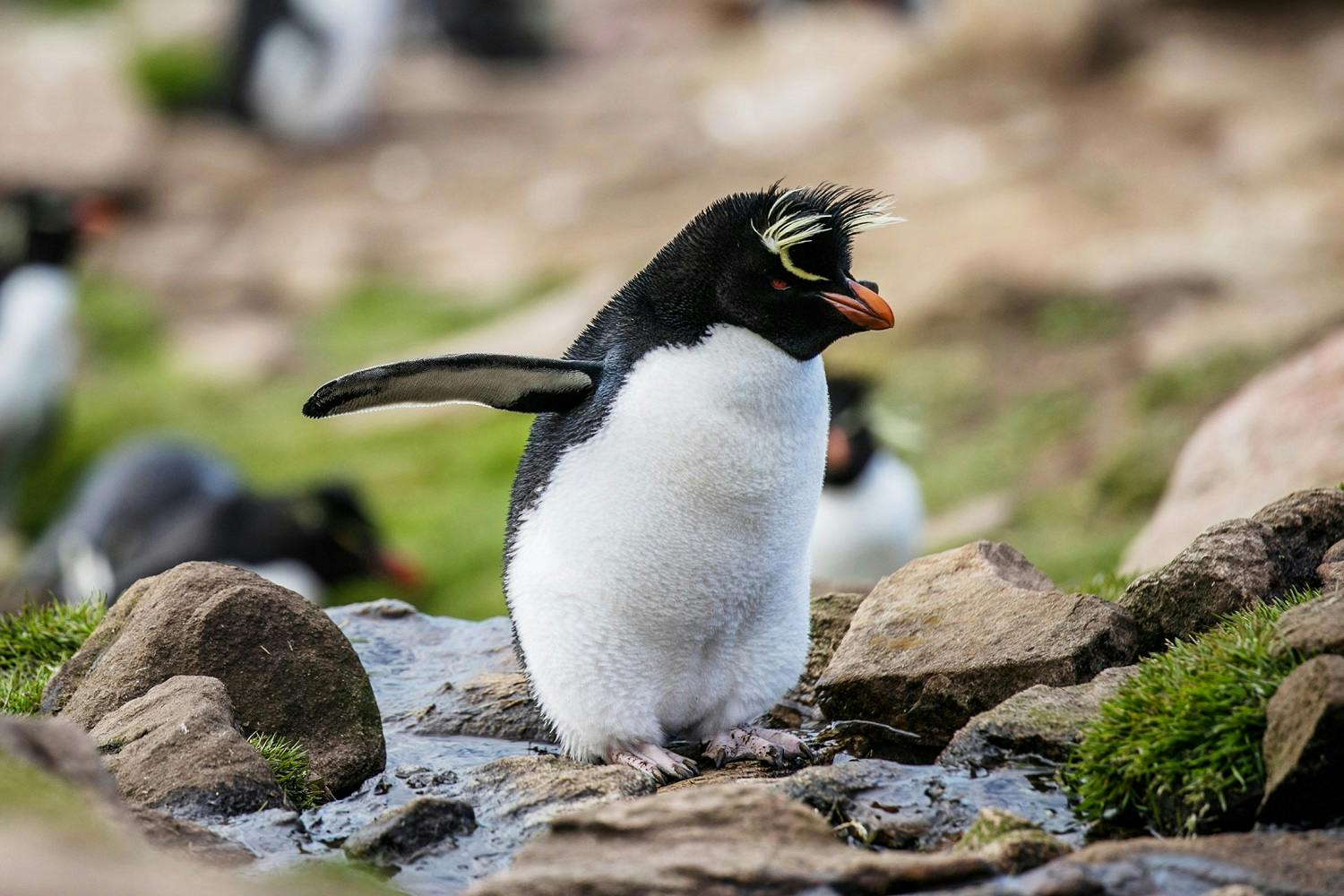Albatross and Penguins: Stepping Into the World of Saunders Island Wildlife
Rare species of flora and fauna and sweeping views distinguish Saunders Island, a Falkland Islands destination dotted with rocky peaks, sheer cliffs, sandy dunes and windswept shores. British explorers established their first Falklands settlement on this sheltered stretch of land in 1765. A plaque at the island’s edge, near the foundations of that original Port Egmont community, describes how explorers proclaimed the location one of the finest harbors in the world.
Today, more than 250 years later, Saunders Island is a working sheep farm and sanctuary for extraordinary plants and wildlife. Nine of the Falklands’ 14 endemic plants grow here, including the threatened hairy daisy and silvery buttercup. Travelers sometimes spot elephant seals, and black-and-white patterned Commerson’s dolphins in the local waters. One of 22 Important Bird Areas in the Falklands, as designated by BirdLife International, Saunders Island is also home to the Silvery Grebe, the Southern Giant Petrel and five species of penguin.
“Most visitors land on the narrow Saunders Island beach called ‘the Neck,'” explains Lex van Groningen, an ornithologist, photographer and Silversea Cruises Expedition Expert. “Four species of penguin can easily be observed on Saunders by simply following the track that leads from this landing beach to the cliffs of Mount Richards.” While exploring Saunders Island with guests, van Groningen likes to share rich details about this region’s seabirds and animal life. Here, he discusses some of the natural diversity of this scenic destination.

Sleek and Spectacular: The Black-Browed Albatross
With an eight-foot wingspan, a snowy white face and a dark streak over each eye, the Black-browed Albatross is the most magnificent seabirds on Saunders Island. Van Groningen recalls one Saunders Island cruise with fellow ornithologist and conservationist Peter Harrison when an albatross landed on the ship’s deck.
“This is something rather uncommon. Although smaller seabirds are known to land on vessels at night, especially when ship lights disorient them in foggy weather, larger birds like albatrosses only rarely land on ships,” he says. The bird stood by as Harrison presented a guest lecture on albatrosses. “After Silver Cloud anchored, Peter’s colleagues…gently lowered the bird back into the water from the zodiac platform.”
Nearly 70 percent of the world’s Black-browed Albatross population clusters in rookery colonies across the Falklands. At the largest colony, near the Neck on Saunders Island, the majestic birds occupy nests on the northern slopes of Mount Richards. Made from mud, guano, grass and seaweed, these pillar-shaped nests stand up to 20 inches tall. During the Southern Hemisphere’s spring season in September, as many as 12,000 albatross pairs choose this elevated locale as their breeding grounds.
“The Falklands are the species’ stronghold. Most colonies are found on the west side of the archipelago, where the Furious Fifties hit the cliffs. These birds are built for strong winds, and only need to throw themselves off the ledge to get airborne,” says van Groningen.

A Visitor Favorite: Rockhopper Penguins
Petite and playful Rockhopper Penguins are easy to spot on Saunders Island, thanks to their vibrant red eyes and yellow eyebrows framed by spiky gold plumes. These agile birds hop up steep rock faces and shower in sparkling streams. A 2010 research study counted about 320,000 Rockhopper Penguin pairs in the Falklands, despite 20th-century population declines linked to food availability. These penguins typically feed on crustaceans, cephalopods and fish.
On Saunders Island, Rockhopper penguins often breed among Black-browed Albatrosses because the larger birds provide protection from predators, explains van Groningen. He recommends watching for Rockhopper Penguins east of the Neck, along the north-facing beachfront.
“There are about 5,600 breeding pairs in this area. Some rocks in the area bear the scratches of penguin claws that have jumped over these stones for thousands of years,” van Groningen says. He reminds guests to respect all of Saunders Island wildlife by preventing unnecessary noises or disturbances and maintaining a safe viewing distance. Falklands Island tourism officials recommend that guests stay at least 20 feet away and give penguins and seabirds the right of way as these animals come ashore and move toward their rookery colonies.

A Birder’s Checklist: Even More Memorable Penguins
Rockhopper Peguins aren’t the only penguin species that guests might spot while exploring Saunders Island. Though penguins are often known as polar-region dwellers, several species thrive in the more temperate Falkland Islands. In fact, more than one million penguins of five different species may nest in the region each summer. King Penguins are the largest species here, growing nearly three feet tall on a diet of small fish and squid. About 20 pairs nest near the Neck, near a much larger colony of Gentoo Penguins. These inquisitive, long-billed foragers tend to travel further from the coast.
“Some 6,700 Gentoo Penguin pairs breed near the Neck. At the end of the season, in March, they molt on the beach and should not be approached at close range to avoid disturbance,” says Van Groningen. Magellanic Penguins breed further from the beaches. Macaroni Penguins have been reported on Saunders Island as well, though they are rarely spotted by travelers.

Agriculture in Action: Saunders Island Sheep
Though Saunders Island lives up to its reputation as a haven for rare and remarkable animals, more common species also flourish here. Sheep farmers established themselves in the Falklands in the late 1800s, and a working sheep farm still anchors Saunders Island. Tony and David Pole-Evans purchased the operation in 1987; today, a small team led by David and Suzan Pole-Evans tends to the farm’s livestock.
The Saunders Island sheep herd includes more than 6,000 rams and ewes. Depending on the season and where guests are exploring, they may see sheep behind farm fences near the Saunders Island Settlement or roaming the weathered coastal lands. These animals produce soft wool that local craftspeople gather and process using traditional methods. They then weave and spin the wool into scarves, apparel and other handcrafted items, while select Falkland Islands shops sell yarn made from Saunders Island wool.
Though it measures just 13 miles across, Saunders Island promises a wealth of wildlife-viewing options for travelers. Since only small expedition ships drop anchor off of this rugged and remote destination, guests enjoy a rare opportunity to see animals up close, undisturbed and authentically engaged in their natural activities.

